Ninety-one Palestinians in the Jordan Valley were forced to leave their homes while the army trained near their homes. Military officials have previously admitted that ‘firing zones’ are being used to expel Palestinians from areas of the West Bank.
By Keren Manor / Activestills.org
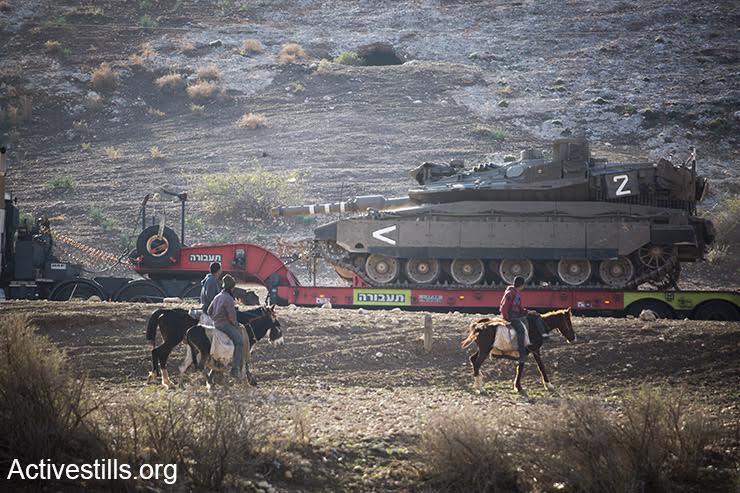
For the past week, the Israeli army has been training in areas designated “firing zones” in the Jordan Valley, in the northeastern edge of the West Bank. As a result dozens of families belonging to the A-Ras al-Ahmar community, as well as three families from Khirbet Humsa — a total of 91 people, of them 15 children — were made to leave their homes midday. An additional hundred families living in various communities in the northern Jordan Valley, adjacent to the firing zones, were given military orders forbidding them to leave the areas around their homes or graze their sheep in the nearby hills during training days.
Evacuating civilians from their homes for the purpose of military training is a contravention of international humanitarian law. Israel, as the occupying power, is not allowed to use occupied territory for military purposes.
This is not the first time the Israeli army holds training exercises in populated areas of the Jordan Valley. In fact, members of the A-Ras al-Ahmar and Khirbet Humsa communities are forced to evacuate their homes every few months under the same pretext. According to statistics provided by Israeli human rights organization B’Tselem, families from A-Ras al-Ahmar had been evacuated eight different times in 2015, while families from Khirbet Humsa were evacuated 19 times in the same year due to military training exercises.
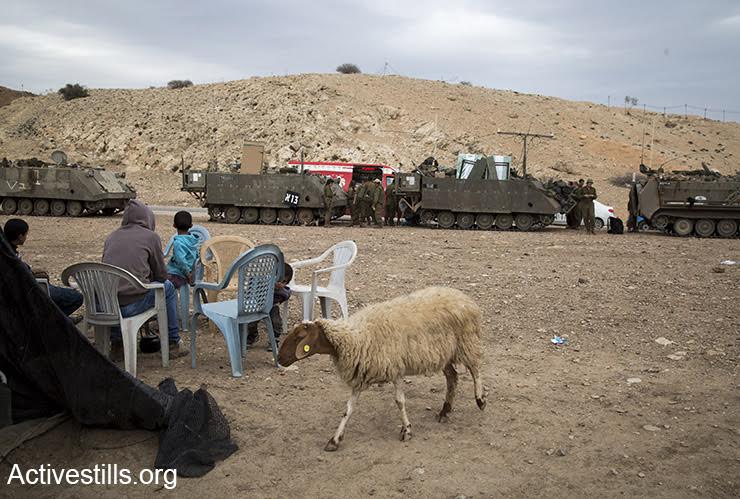
On Thursday, the final day of the training, Ali Beni Odeh, a resident of A-Ras al-Ahmar told +972 Magazine that every time the army arrives for training, the community must evacuate and leave their livestock in enclosures by the tent encampments by themselves. The families’ inability to work their land or tend to their animals while they are at pasture means their livelihoods take a significant hit. “We leave without anything, only with the clothes on our backs, and stay away for hours without anything, without any provisions. We cannot even go to our homes to bring water.”
They carry few supplies by foot, since the army confiscated their tractor before the training was set to start. Just in the past two months the army confiscated 10 tractors from families in the A-Ras al-Ahmar community. “This is the only area we have,” says Ali. “If we had somewhere to go we would, but if we leave here we will have to sell our livestock.” This past January, the army attempted to evacuate 10 families from a-Ras al-Ahmar, yet weather conditions prevented them from doing so. This, however, did not stop soldiers from training adjacent to the camp, who damaged agricultural land and the main access road to the village. “This great affects us, especially the children. They have nightmares. They cry in their sleep. They are afraid of the trainings because of their proximity. What will we do… our lives are difficult,” Ali tells me.
A ‘new’ routine
An ice cream truck passes between the soldiers who walk around during their breaks, while the Palestinians who were not forced from their homes watch as tanks pass by their homes. “They didn’t cause us any trouble,” one of them tells me, “they just told us not to walk around or take the sheep beyond the area of the house this week.”
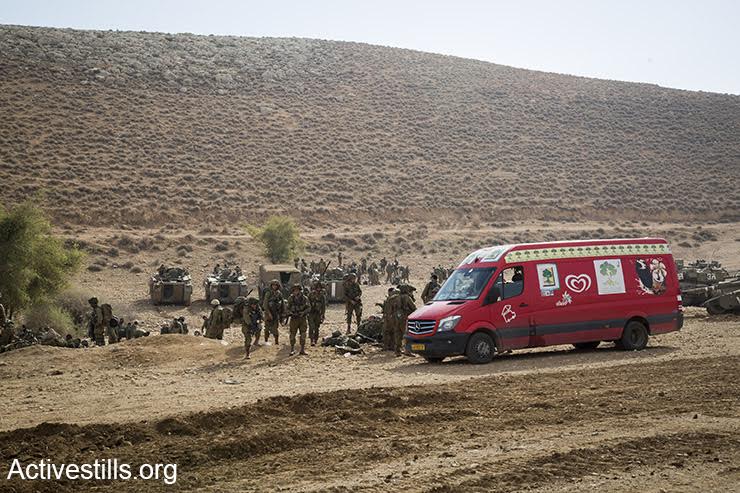
Eighty-eight percent of the Jordan Valley, which makes up more than a fourth of the West Bank, is defined as Area C, which means it falls under full Israeli military control. Nearly every place Palestinians in the Jordan Valley can move to is settlement territory, a nature reserve, or a firing zone, severely restricting their movement and ability to build a home. It means living under a regime in which most things are off limits.
The approximately 2,700 Palestinians living in 20 small communities have been living in what the military has termed “live-fire zones” since the 1970s. In 2009 the army began systematically placing dozens of concrete roadblocks around these communities, designating the territory an firing zone where entrance is forbidden. By 2012 the evacuation of families from these areas became more commonplace — today it has become a routine.
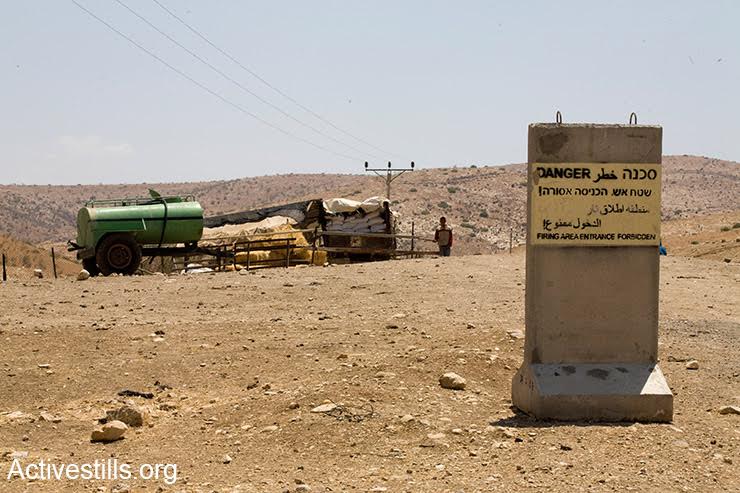
Traces of Israeli forces remained in the area even after the army left. B’Tselem researcher A’araf Drarma reported that 500 dunam of agricultural land, used mostly for growing corn, was left in ruins. The training exercises on the land pose a risk to the lives of the residents due to duds left in the area.
A struggle against illegal construction?
In 2014 Haaretz journalist Amira Hass published an article which revealed how the army had been increasingly conducting training in the Jordan Valley and other areas of the West Bank as a means of decreasing the number of Palestinian residents there, as well as to combat illegal construction. Hass published the protocol of a closed-door Knesset committee meeting during which Col. Einav Shalev, operations officer of Central Command, argued before the committee that the desire to fight against illegal construction is one of the main reasons that the IDF had been increasing its training in the West Bank:
I think that one of the positive processes that can slip through our fingers is the return of firing zones to a places they are supposed to be yet are not there. This is one of the main reasons that the military establishment conducts many trainings in the Jordan Valley. That is, anyone who looks at the last division training with fighter jets, helicopters and tanks that used artillery, etc… We are now introducing an additional division training in this area…in places where we significantly reduced the amount of training, weeds have grown. This is something that should be taken into consideration.
It’s enough to look at Ali Beni Odeh and his family to understand the effectiveness of military training as a means of creating pressure on the Palestinian residents. A shepherd who cannot herd, destroyed agricultural land, and confiscated tools only make it more difficult for the local population, which largely lives off land and livestock, to survive.
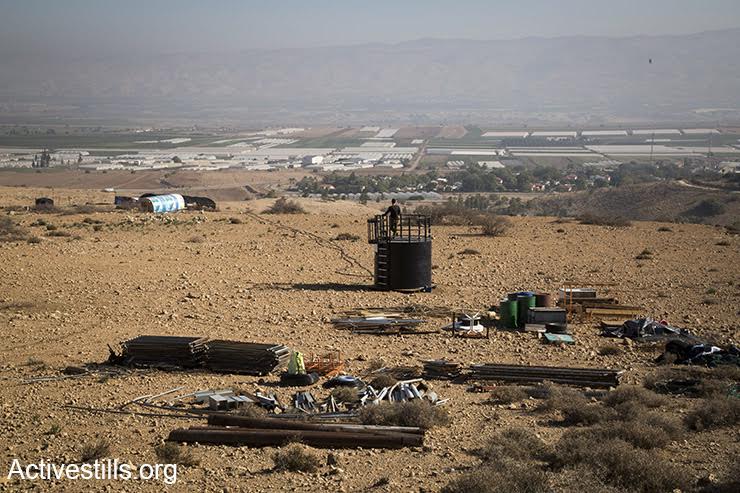
Col. Shalev also told the committee that he makes no distinction between Jews and Palestinians. But the reality on the ground actually does make that distinction. It is unsurprising, for instance, that not one of the 39 settlements or outposts scattered across the Jordan Valley has been affected by the training.
In fact, around the time that these communities were evacuated, settlers built a small outpost adjacent to the settlement of Mehola. The caravan and animal pen, both of which were erected several months ago, are likely to expand, as indicated by a small garden that was recently planted, along with a pile of beds and pieces of furniture.
A struggle against illegal construction? Depends how you look at it.


